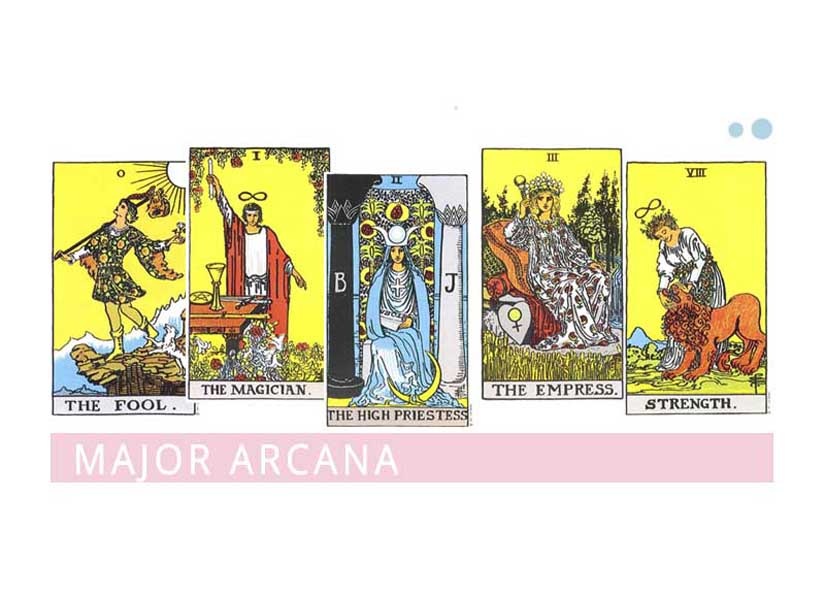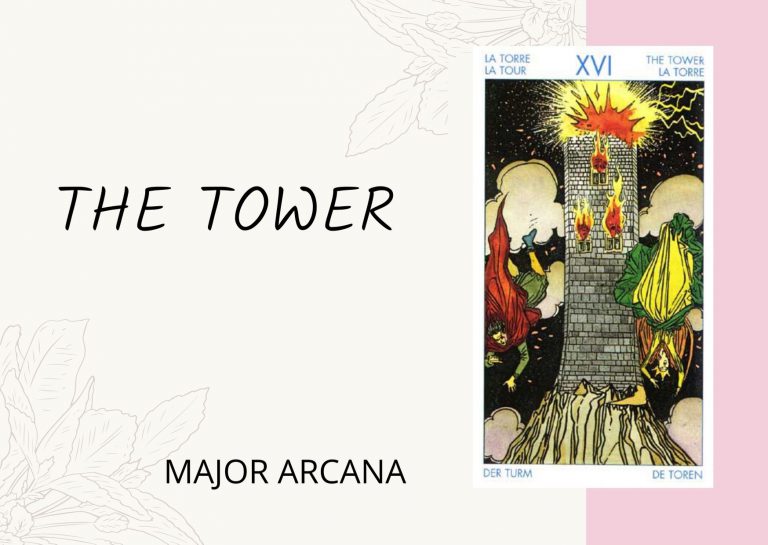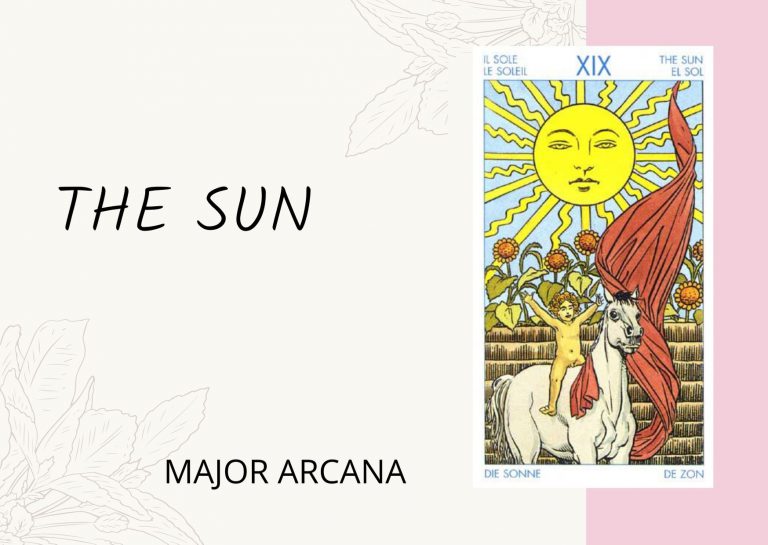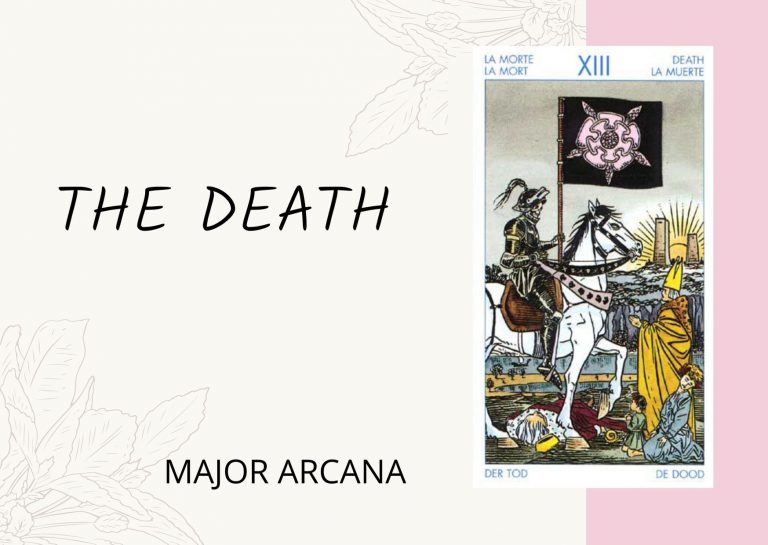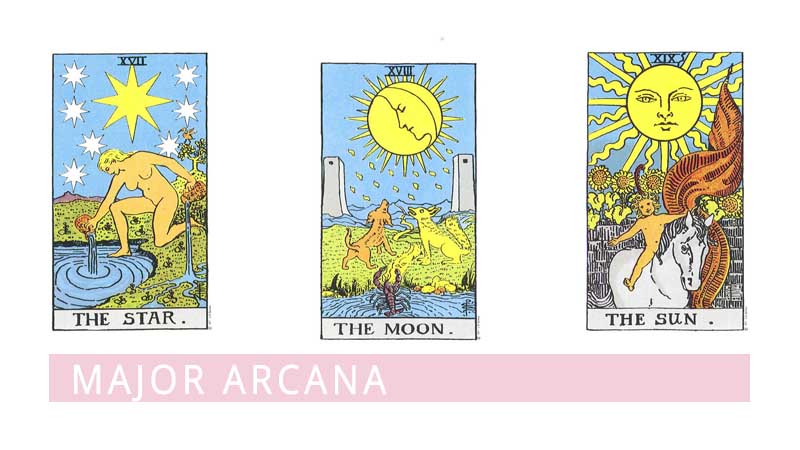
The Major Arcana of the Tarot: cards 14-21
Temperance. The winged figure of a female. Who, in opposition to all doctrine concerning the hierarchy of angels, is usually allocated to this order of ministering spirits – is pouring liquid from one pitcher to another.
In his last work on the Major Arcana Tarot, Dr. Papus abandons the traditional form and depicts a woman wearing an Egyptian head-dress. The first thing which seems clear on the surface is that the entire symbol has no especial connection with Temperance. And the fact that this designation has always obtained for the card offers a very obvious instance of a meaning behind meaning, which is the title in chief to consideration in respect of the Tarot as a whole.
The Devil. In the 18-th century this card seems to have been rather a symbol of merely animal impudicity. Except for a fantastic head-dress, the chief figure is entirely naked; it has bat-like wings, and the hands and feet are represented by the claws of a bird. In the right hand there is a scepter terminating in a sign which has been thought to represent fire.
The figure as a whole is not particularly evil. It has no tail. And the commentators who have said that the claws are those of a harpy have spoken at random. There is no better ground for the alternative suggestion that they are eagle’s claws. Attached, by a cord depending from their collars, to the pedestal on which the figure is mounted, are two small demons, presumably male and female. These are tailed but not winged.
Since 1856 the influence of Eliphas Lévi and his doctrine of occultism has changed the face of this card. And it now appears as a pseudo-Baphometic figure with the head of a goat and a great torch between the horns; it is seated instead of erect, and in place of the generative organs there is the Hermetic caduceus. In Le Tarot Divinatoire of Papus the small demons are replaced by naked human beings. Male and female, who are yoked only to each other. The author may be felicitated on this improved symbolism.
The Tower. This card depicts a tower struck by lightning. Its alternative titles are: Castle of Plutus, God’s (Nature’s) House and the Tower of Babel. In the last case, the figures falling therefrom are held to be Nimrod and his minister.
It is assuredly a card of confusion, and the design corresponds. Broadly speaking, to any of the designations except Maison Dieu, unless we are to understand that the House of God (Nature) has been abandoned and the veil of the temple rent. It is a little surprising that the device has not so far been allocated to the destruction of Solomon’s Temple. When the lightning would symbolize the fire and sword with which that edifice was visited by the King of the Chaldees.
The Star (seldom Dog-Star, or Sirius). It’s also called fantastically the Star of the Magi. Grouped about it are seven minor luminaries, and beneath it is a naked female figure, with her left knee upon the earth and her right foot upon the water. She is in the act of pouring fluids from two vessels.
A bird is perched on a tree near her; for this a butterfly on a rose has been substituted in some later cards. So also the Star has been called that of Hope. This is one of the cards which Court de Gebelin describes as wholly Egyptian.
The Moon. Some 18-th-century cards show the luminary on its waning side. In the debased edition of Etteilla, it is the moon at night in her plenitude, set in a heaven of stars; of recent years the moon is shown on the side of her increase. In nearly all presentations she is shining brightly and shedding the moisture of fertilizing dew in great drops.
Beneath there are two towers, between which a path winds to the verge of the horizon. Two dogs, or alternatively a wolf and dog, are baying at the moon. And in the foreground there is water, through which a crayfish moves towards the land.
The Sun. The luminary is distinguished in older cards by chief rays that are waved and salient alternately and by secondary salient rays. It appears to shed its influence on earth not only by light and heat, but, like the moon, by drops of dew. Court de Gebelin termed these tears of gold and of pearl just as he identified the lunar dew with the tears of Isis.
Beneath the Star there is a wall suggesting an enclosure, as it might be, a walled garden. Wherein are two children, either naked or lightly clothed, facing a water, and gambolling, or running hand in hand. Eliphas Lévi says that these are sometimes replaced by a spinner unwinding destinies, and otherwise by a much better symbol – a naked child mounted on a white horse and displaying a scarlet standard.
Judgment. The last judgment. We have spoken of this symbol already, the form of which is essentially invariable, even in the Etteilla set. An angel sounds his trumpet per sepulchra regionum, and the dead arise. It matters little that Etteilla omits the angel, or that Dr. Papus substitutes a ridiculous figure, which is, however, in consonance with the general motive of that Tarot set which accompanies his latest work.
Before rejecting the transparent interpretation of the symbolism which is conveyed by the name of the card and by the picture which it presents to the eye, we should feel very sure of our ground. On the surface, at least, it is and can be only the resurrection of that triad. Father, mother, child – whom we have met with already in the 8-th card.
M. Bourgeat hazards the suggestion that esoterically it is the symbol of evolution – of which it carries none of the signs. Others say that it signifies renewal, which is obvious enough; that it is the triad of human life. That it is the “generative force of the earth … and eternal life.” Court de Gebelin makes himself impossible as usual, and points out that if the grave-stones were removed it could be accepted as a symbol of creation.
The World (sometimes the Universe, or Time). The four living creatures of the Apocalypse and Ezekiel’s vision, attributed to the evangelists in Christian symbolism, are grouped about an elliptic garland. They stay as if it were a chain of flowers intended to symbolize all sensible things. As you can see within this garland there is the figure of a woman, whom the wind has girt about the loins with a light scarf, and this is all her vesture. She is in the act of dancing, and has a wand in either hand.
It is eloquent as an image of the swirl of the sensitive life, of joy attained in the body, of the soul’s intoxication in the earthly paradise, but still guarded by the Divine Watchers, as if by the powers and the graces of the Holy Name, Tetragammaton. Those four ineffable letters which are sometimes attributed to the mystical beasts.
It should be noted that in the four quarters of the garland there are four flowers distinctively marked. According to P. Christian, the garland should be formed of roses. And this is the kind of chain which Eliphas Lévi says is less easily broken than a chain of iron. Perhaps by antithesis, but for the same reason, the iron crown of Peter may lie more lightly on the heads of sovereign pontiffs than the crown of gold on kings.
The Major Arcana of the Tarot ends with the World. If you want to learn more about tarot cards meanings, you are welcome to our Tarot Meanings Category.
